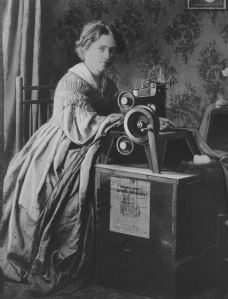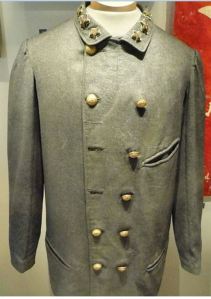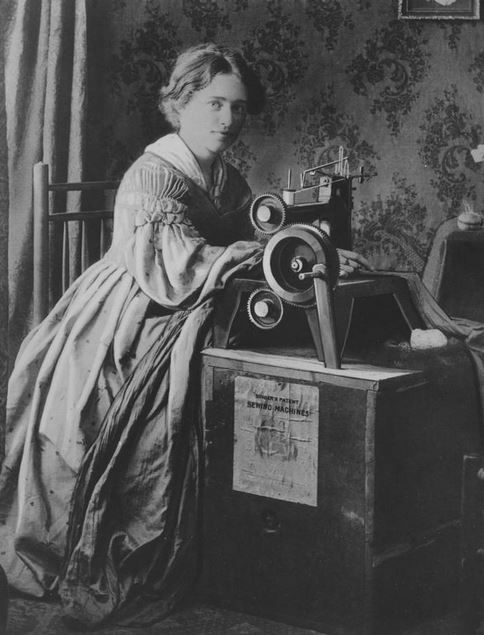 The elegance, speed, noiselessness and simplicity of the machine; the beauty and strength of the stitch:…impossible to ravel, and leaving no chain or ridge on the under side; the economy of thread and adaptability to the thickest or thinnest fabrics, have rendered this the most successful and popular sewing machine made. (Advertisement for a Weber Sewing Machine The Illinois Farmer VI 1861)
The elegance, speed, noiselessness and simplicity of the machine; the beauty and strength of the stitch:…impossible to ravel, and leaving no chain or ridge on the under side; the economy of thread and adaptability to the thickest or thinnest fabrics, have rendered this the most successful and popular sewing machine made. (Advertisement for a Weber Sewing Machine The Illinois Farmer VI 1861)
Although only perfected in 1854, seven years later the sewing machine was to play a major role in the production of uniforms for the Civil War.
Anyone who has every used a sewing machine knows that the formation of machine stitches depends on a complex arrangement of thread, needle, bobbin, and tension. It took much experimentation to develop machines that could replace hand sewing. The first attempts were most notable for their failure. For example, the Americans James Adams Dodge and John Knowles are credited with inventing the first American sewing machine in  1814. However, their machine broke before sewing more than a negligible amount of fabric. Several other designs were patented, but because they tried to imitate hand sewing they were unsuccessful.
1814. However, their machine broke before sewing more than a negligible amount of fabric. Several other designs were patented, but because they tried to imitate hand sewing they were unsuccessful.
In Paris in 1830 Barthelemy Thimonnier, a tailor, broke with the model of hand sewing and built the first chain or lock stitch machine. His machine worked, but he was nearly killed by irate tailors who believed rightly that the machine would lose them their jobs. In the United States in 1833 Walter Hunt, inventor of the safety-pin, designed the first American lock stitch machine but never patented it because he feared attack by the Trade Unionists for the same reason.

It was Elias Howe who improved and patented the first American lock stitch machine in 1854 and produced the first commercially viable machine. His machine could sew 250 stitches per minute or the equivalent to 5 hand-sewers- a phenomenal economic savings. In 1854 he went to England to try to market it, only to find on his return that Isaac Singer and others had infringed on his patent. He won his case against Singer, but patent infringement became so intense that it led to what has been characterized as the Sewing Machine War. (Similar to modern-day patent infringement battles such as those over smartphones)
In the end, the sewing machine companies joined together and pooled their patents, enabling sewing machine manufacture to blossom into a major American industry. Isaac Singer i
ncreased sales across the country by producing machines on a huge scale and through aggressive advertising. You can find advertisements for sewing machines in almost every magazine and newspaper and back pages of books of the time. By using interchangeable parts, he was able to reduce the price from $100 to $10 and instituted buying the machines on time, so that women of all classes could have machines in their homes. It was a major success. In 1860 alone he produced 13,000 machines.
Despite worries about the effect of using the machines on employment of tailors and seamstresses, and Virginia Penny’s analysis of the physical effects on women laborers’ health (The Employment of Women 1863, p. 310), over 300,000 machines were estimated to have been in use in the United States by 1860 with a profound influence on the production of clothing for men and women particularly shirts, shirt fronts, collars, and cloaks. In Troy, New York $800,000 worth of shirt collars were produced. (Journal of the Society of Arts, Vol. 11 1863). The following chart from The Journal of Society Arts p. 357 gives some idea of the size of the industry in 1860 – only six years after the machines came onto the market.

Nevertheless, it was the Civil War that firmly established the sewing machine as a replacement for hand-sewing. With the need for thousands of uniforms, the Union army instantly sought to make use of the machines. Quartermaster Meigs asked army suppliers to “set the innumerable needle and sewing machines at [their command] to work any durable cloth…to make uniforms…” (A. Breakwell, 2010, “A Nation in Extremity”). Forage caps, haversacks, and shoes were all ordered to be machine sewn. No only were they more durable, but also cheaper. The demand was so great that one company advertised for women to bring their own machines to the factory to make shelter tents for $6 to $12 a week (Breakwell). With the war demand, by 1863 Singer alone was selling 20,000 machines a year. Elias Howe, between 1854 and 1867 earned over two million dollars from his patent, and became wealthy enough to be able to fully equip an infantry regiment in the Union Army.
However, as the chart above illustrates, all of the sewing machine manufacturers were located in the north. This caused a great disadvantage to the South in supplying uniform components to the troops. On October 8, 1862 recognizing this the Confederate government authorized the duty-free import of machinery for clothing manufacture. However, the effect was

http://commons.wikimedia.org/wiki/File%3AConfederate_officer’s_uniform%2C_gray_wool_sack_coat%2C_1861-1862_-_North_Carolina_Museum_of_History_-_DSC05996.JPG
probably minimal. In an examination of hundreds of uniforms in museums, Ann Breakwell found machine sewing on a large percentage of Union uniforms (76%) but on only a few Confederate uniforms (2%). So based on this research it would seem that the majority of Confederate uniforms, except perhaps for those imported from England or sewn on home machines, were hand sewn by tailors and seamstresses. However, more extensive research is probably needed to fully delineate the role of machine sewing in the South.

For more information on how sewing machines were invented and how they worked see Rudolf Hertzberg The Sewing Machine: Its History, Construction, and Application 1864
For more on the role of machine sewing in Civil War uniform manufacture see:
A. Breakwell, “A Nation in Extremity” Textile History and the Military (1) supplement, 98–107, May 2010


i make leather goods and canvas goods on old singers for leather i have a 1873 class 7 at can sew up to 1 in leather for canvas i have a 1899 singer
LikeLike
I have a treadle Singer machine too, and it definitely a lot tougher than my modern machine. I always stitch my jeans on it. It’s beautiful too with lovely Egyptian designs and an oak cabinet. Got it for $20 at the Salvation Army many years ago.
LikeLike